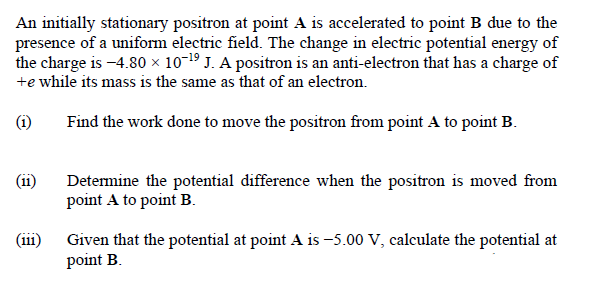An initially stationary positron at point A is accelerated to point B due to the presence of a uniform electric field. The change in electric potential energy of the charge is -4.80 × 10-19 J. A positron is an anti-electron that has a charge of +e while its mass is the same as that of an electron. (i) Find the work done to move the positron from point A to point B. (ii) Determine the potential difference when the positron is moved from point A to point B. (iii) Given that the potential at point A is -5.00 V, calculate the potential at point B.
An initially stationary positron at point A is accelerated to point B due to the presence of a uniform electric field. The change in electric potential energy of the charge is -4.80 × 10-19 J. A positron is an anti-electron that has a charge of +e while its mass is the same as that of an electron. (i) Find the work done to move the positron from point A to point B. (ii) Determine the potential difference when the positron is moved from point A to point B. (iii) Given that the potential at point A is -5.00 V, calculate the potential at point B.
Principles of Physics: A Calculus-Based Text
5th Edition
ISBN:9781133104261
Author:Raymond A. Serway, John W. Jewett
Publisher:Raymond A. Serway, John W. Jewett
Chapter20: Electric Potential And Capacitance
Section: Chapter Questions
Problem 7CQ
Related questions
Question

Transcribed Image Text:An initially stationary positron at point A is accelerated to point B due to the
presence of a uniform electric field. The change in electric potential energy of
the charge is -4.80 × 10-19 J. A positron is an anti-electron that has a charge of
+e while its mass is the same as that of an electron.
(i)
Find the work done to move the positron from point A to point B.
(ii)
Determine the potential difference when the positron is moved from
point A to point B.
(iii)
Given that the potential at point A is -5.00 V, calculate the potential at
point B.
Expert Solution
This question has been solved!
Explore an expertly crafted, step-by-step solution for a thorough understanding of key concepts.
Step by step
Solved in 2 steps

Knowledge Booster
Learn more about
Need a deep-dive on the concept behind this application? Look no further. Learn more about this topic, physics and related others by exploring similar questions and additional content below.Recommended textbooks for you

Principles of Physics: A Calculus-Based Text
Physics
ISBN:
9781133104261
Author:
Raymond A. Serway, John W. Jewett
Publisher:
Cengage Learning

Physics for Scientists and Engineers: Foundations…
Physics
ISBN:
9781133939146
Author:
Katz, Debora M.
Publisher:
Cengage Learning

College Physics
Physics
ISBN:
9781305952300
Author:
Raymond A. Serway, Chris Vuille
Publisher:
Cengage Learning

Principles of Physics: A Calculus-Based Text
Physics
ISBN:
9781133104261
Author:
Raymond A. Serway, John W. Jewett
Publisher:
Cengage Learning

Physics for Scientists and Engineers: Foundations…
Physics
ISBN:
9781133939146
Author:
Katz, Debora M.
Publisher:
Cengage Learning

College Physics
Physics
ISBN:
9781305952300
Author:
Raymond A. Serway, Chris Vuille
Publisher:
Cengage Learning

Physics for Scientists and Engineers, Technology …
Physics
ISBN:
9781305116399
Author:
Raymond A. Serway, John W. Jewett
Publisher:
Cengage Learning
